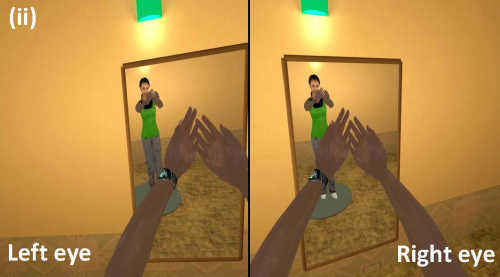Talking a walk in someone else’s shoes

This takes the meaning of walking in someone else’s shoes to a whole new level. UK researchers have conducted a study that allowed participants to take on the body of another person from a different race, age or sex, to see if it changed the way they feel about themselves and their biases.
Professor Manos Tsakiris of the Royal Holloway University of London and Professor Mel Slater of University College London and the University of Barcelona used the brain’s ability to bring together information from different senses to make white people feel that they were inhabiting black bodies and adults feel like they had children’s bodies. The results of the interesting study were incredible – biases ingrained in the participants from a young age were diminished, meaning that this unique research could help to dispel racism and discrimination in society. In the adults who felt as if they had children’s bodies, they felt that they were more childlike even after the study.
The results were so remarkable because negative attitudes about others are often formed when we are young and continue on through our lives, but this experiment was an effective tool in reversing them. It was the first experiment of its type that examined whether implicit social biases can change. According to Professor Tsakiris, “Our findings are important as they motivate a new research area into how self-identity is constructed and how the boundaries between ‘ingroups’ and ‘outgroups’ might be altered…More importantly though, from a societal point of view, our methods and findings might help us understand how to approach phenomena such as racism, religious hatred, and gender inequality discrimination, since the methods offer the opportunity for people to experience the world from the perspective of someone different from themselves”. And wouldn’t that be wonderful?

The Rubber Hand Illusion: Light-skinned Caucasian participants observe a dark-skinned rubber hand being stimulated in synchrony with their own unseen hand. This elicits a shift of body ownership to incorporate the other-race limb. Adapted and reproduced, with permission, from reference.
The Enfacement Illusion: Participants viewed the face of a racial outgroup member being stimulated in synchrony with their own to induce a sense of ownership over the observed face.
Immersive Virtual Reality: A participant wears a wide field-of-view stereo head-tracked head-mounted display and a motion capture suit for real-time body tracking.
This is the participant’s view of the situation, whereby she can see her virtual body both directly and reflected in the mirror, in stereo as shown. The body she sees could be dark-skinned, light-skinned, or purple; in this case, the virtual body is dark skinned whereas she is light skinned.
Credit: Trends in Cognitive Sciences, Maister et al.
Other research suggests that humans truly cannot empathise as deeply as we think we can – and it makes sense. Our struggles and our pain will always hurt the most because it’s us, but this amazing body swap could change that and make us truly know what it feels like to be someone else.
The UK study showed that the brain really can update its model and change our attitudes towards one another. And isn’t that what we all want – to be understanding and less critical of others?
Would you use the body swap technology? Would you like to feel what it’s like to be in someone else’s body? Tell us below how you think this could change our world if it were ready available.










 Proudly Australian owned and operated
Proudly Australian owned and operated